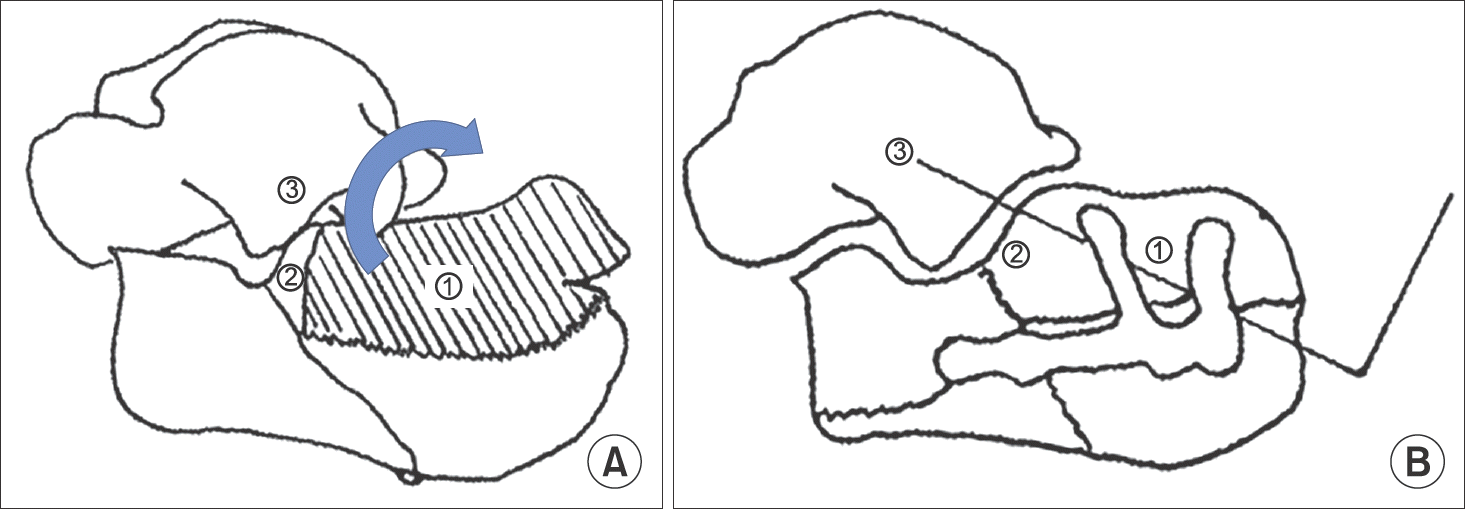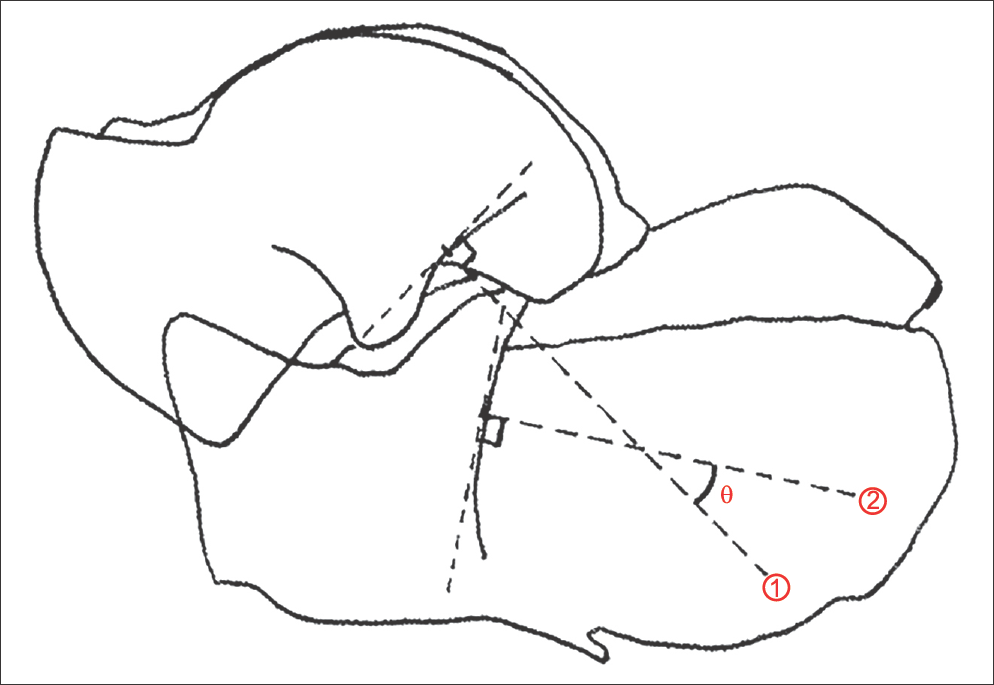Abstract
Purpose:
This study was designed to evaluate the clinical efficacy of temporary K-wire fixation in F-plate fixation for displaced intra-articular calcaneal fractures.
Materials and Methods:
Two groups (group 1 with F-plate fixation only and group 2 with temporary K-wire fixation and F-plate fixation) of patients were included in this study. The temporary K-wire was removed six weeks after the operation. Each group consisted of 33 cases. Rotational axis angles were measured radiographically and the foot and ankle outcome score (FAOS) was used for clinical assessment.
Results:
In group 1, the mean rotational axis angle was reduced from 27o preoperatively to 5.59o postoperatively and the angle at last follow-up was 9.94o. There was an increase in angle of 4.35o between postoperative and the last follow-up measurement. In group 2, the mean rotational axis angle was reduced from 21.2o preoperatively to 4.39o postoperatively and the angle at last follow-up was 5.91o. There was an increase in angle of 1.52o between postoperative and the last follow-up measurement. Significant difference in the changes of rotational axis angle was observed between the two groups. However, no significant difference in FAOS was observed between the two groups.
Go to : 
REFERENCES
1.Tomesen T., Biert J., Frölke JP. Treatment of displaced intra-articular calcaneal fractures with closed reduction and percutaneous screw fixation. J Bone Joint Surg Am. 2011. 93:920–8.

2.Sanders R. Displaced intra-articular fractures of the calcaneus. J Bone Joint Surg Am. 2000. 82:225–50.

3.Bae SY., Shin YK., Kim JO., Lee JH., Lee CW., Shin JH. Evaluation of rotational displacement of the posterior facet on the sagittal plane in computed tomographic images of calcaneal fractures. J Korean Fract Soc. 2005. 18:165–9.

4.Roos EM., Brandsson S., Karlsson J. Validation of the foot and ankle outcome score for ankle ligament reconstruction. Foot Ankle Int. 2001. 22:788–94.

5.Crosby LA., Fitzgibbons T. Computerized tomography scanning of acute intra-articular fractures of the calcaneus. A new classification system. J Bone Joint Surg Am. 1990. 72:852–9.

6.McLaughlin HL. Treatment of late complications after os calcis fractures. Clin Orthop Relat Res. 1963. 30:111–5.
7.Paley D., Hall H. Intra-articular fractures of the calcaneus. A critical analysis of results and prognostic factors. J Bone Joint Surg Am. 1993. 75:342–54.

8.Buckley R., Tough S., McCormack R., Pate G., Leighton R., Petrie D, et al. Operative compared with nonoperative treatment of displaced intra-articular calcaneal fractures: a prospective, randomized, controlled multicenter trial. J Bone Joint Surg Am. 2002. 84:1733–44.
9.Mulcahy DM., McCormack DM., Stephens MM. Intra-articular calcaneal fractures: effect of open reduction and internal fixation on the contact characteristics of the subtalar joint. Foot Ankle Int. 1998. 19:842–8.

Go to : 
 | Figure 1.(A) This is a schematic diagram of the classic Essex-Lopresti ‘tongue-type’ fracture. Postero-inferior traction and rotation force are necessary for reduction of posterior facet and calcaneal tuberosity fragments. (B) This is a schematic diagram of the temporary K-wire fixation followed by F-plate fixation. ①: calcaneal tuberosity, ②: subtalar joint, ③: talar body. |
 | Figure 2.These are lateral radiographs of the right calcaneus. (A) This is a preoperative radiograph of 32-year-old male patient’s calcaneus, showing the classic Essex-Lopresti ‘joint depression type’ and ‘tongue type’ fracture. (B) This is a postoperative radiograph showing open reduction with temporary percutaneous K-wire fixation from calcaneal tuberosity through subtalar joint to talar body, followed by F-plate fixation. (C) This is a follow-up radiograph, 2 years after the operation, showing a good reduction state of posterior calcaneal facet. |
 | Figure 3.This is a schematic diagram of ‘rotational axis angle (θ)’ of calcaneus in lateral radiograph. Rotational axis angle is the angle between two tangent lines, ① and ②. ①: tangent line of center in talar posterior articular facet, ②: tangent line of center in calcaneal posterior articular facet, rotated and displaced anteriorly and inferiorly. |
Table 1.
Perioperative Changes of Rotational Axis
| Rotational axis (o) | Group 1 | Group 2 |
|---|---|---|
| Preoperative | 27 | 21.2 |
| Postoperative | 5.59 | 4.39 |
| Postoperative 6 mo | 9.94 | 5.91 |




 PDF
PDF ePub
ePub Citation
Citation Print
Print


 XML Download
XML Download